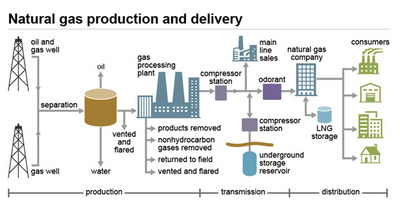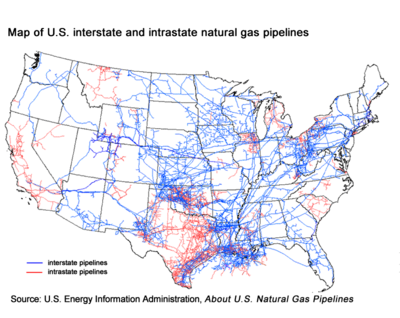Natural Gas Industry
Introduction
The natural gas industry consists of a variety of entities with differing functions. Following is a simplified listing of the types of companies that constitute the makeup of the natural gas industry:
- Producers
- These are the owners and developers of natural gas wells. They can range from giant corporations to one or two person well owners.
- Processing
- Processing corporations are comparable to refinery companies in the oil industry. They separate the natural gas taken from earth into its marketable components, mostly methane.
- Pipelines
- Pipeline companies transport processed natural gas to locales where it can be stored and later marketed.
- Storage
- Storage operators own and control numerous underground storage facilities for natural gas. The gas is stored for later marketing and, in some cases, as safeguards to be used in emergencies.
- Marketing
- Marketing companies facilitate connections between those entities in the industry that produce, process, transport and store natural gas and the retailers and end users who purchase the final, delivered products.
- Local Distribution Companies (LDC)
- LDC's bring natural gas to the end users via local pipelines.
Production and Delivery

NG Production and Delivery Process
Source: EIA Natural Gas Explained
There are three principal stages in the production and delivery of natural gas:
- processing
- transportation
- storage
NG Pipelines

The U.S. natural gas industry has about 3 million miles of pipeline of various sizes that provide natural gas to about 74 million customers. There are several steps in the transportation and delivery process as follows:
- Gathering systems are relatively small pipelines that carry natural gas from the wellhead, where it was extracted from the Earth, to natural gas processing plants.
- Natural gas processing plants separate non-methane compounds from the raw natural gas. These non-methane compounds include hydrocarbon gas liquids (HGL), water and various non-hydrocarbon gases. The processed natural gas is then sent to a mainline transmission system for further delivery.
- The mainline transmission system is an array of large-diameter pipelines that carry the processed natural gas to storage facilities and distribution centers.
- Local distribution companies use smaller diameter pipelines to deliver the natural gas to customers. There are about 1.5 million miles of these small diameter pipelines involved in this task.